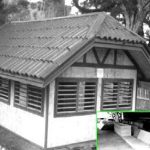
Coconut Fiber Cement Board (CFB) is a panel manufactured from the mixture of fibrous materials like coconut coir or shredded woody portion of coconut tree and Portland cement at a ratio of 60-70% cement to 30 -40% fiber by weight. It is made by forming the cement-fiber mixture into mats and pressing them to the desired thickness.


Research studies conducted at PCA-ZRC have shown that CFB panels have good strength properties and high dimensional stability when soaked in water (water absorption of 32% and thickness swelling of 4.2%) surpassing the minimum requirements set by PHILSA-Standard 105-1975. It has low thermal conductivity (k-value 0f 0.90 W/mk) which indicates its excellent insulation properties, thus it can be used as roofing materials even without ceiling. Flame test showed that, while the board can be burned, it is rather slow with minimal smoke emission. Exposure test of paint-coated CFB roof sheets has demonstrated their capability to withstand the deleterious effect of weathering found in actual service condition.
Uses of Coconut Fiber Cement Board (CFB) * CFB can replace traditional construction materials such as tiles, bricks, plywood, asbestos and cement hollow blocks. * Roof Sheathing * Base support for upper level flooring * Internal and exterior walls, partitions and ceiling * It can be used for or as a component in the fabrication of furniture (tables, chairs, desks, etc.), cabinets, boxes and vases.
MANUFACTURING PROCESS The production of Coconut Fiber Cement Board (CFB) involves the following steps: 1. Soaking of dried husk in tap water for 24 to 48 hours 2. Decorticating of husk to produce fibers 3. Soaking of fibers in separate dipping tank for 2 days to remove the extractives 4. Draining of the fibers 5. Mixing the required amount of fiber, cement and water in the blending machine 6. Mat-forming using wooden form box and plywood cauls lined with plastic sheets 7. Pressing the mat to the desired thickness for 24 hours using the hydraulic press machine 8. Fillet-stacking for air drying/conditioning 10. Drying and conditioning of the boards 11. Trimming/sizing of the boards
EQUIPMENT/MACHINERY The major equipment used in the manufacture of CFB are all fabricated locally except the lifter and include the following: 1. Decorticating machine 2. Hydraulic press 3. Blending machine 4. Trimming machine 5. Lifter Mr. LUISITO J. PEÑAMORA Division Chief III PCA-Zamboanga Research Center San Ramon, 7000 Zamboanga City E-mail: pca_zrc@dslpldt.net Tel/Fax 062-9820302 Source: neda.gov.ph
Source: Business Diary Philippines


0 Comments